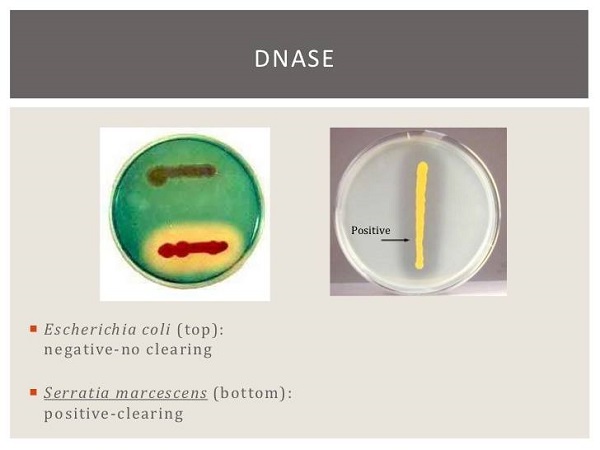Deoxyribonuclease (DNase) Test- Principle, Uses, Procedure, Result Interpretation, Quality Control, Examples and Limitations
Deoxyribonuclease (DNase) Test- Principle, Uses, Procedure, Result Interpretation, Quality Control, Examples and Limitations
This test is presumptively used to differentiate Staphylococcus aureus which produces the enzyme deoxyribonuclease from other Staphylococci which do not produce deoxyribonuclease (DNase). Staphylococcus aureus possesses a heat-stable enzyme, a thermonuclease. To detect this enzyme, first the organisms are destroyed by heat and then the free DNase reacts with the medium. This test is also given positive by Vibrio, Helicobacter, Moraxella, Serratia, and Aeromonas.
Principle
This test determines the ability of an organism that produce DNase. DNase are extracellular endonucleases that cleave DNA and release free nucleotides and phosphate. To detect these enzymes, DNase agar using no indicators or various indicators (toluidine blue or methyl green) are used to detect the hydrolysis of DNA.
In DNase agar without indicator, the hydrolysis of DNA is observed by a clearing of the agar after addition of HCL (oligonucleotides dissolves in acid but DNA salts are insoluble). The acid precipitates unhydrolyzed DNA making the medium opaque. Therefore, DNase producing colonies hydrolyze DNA and produce a clear zone around the growth.
In case of DNase agar with methyl green, DNA combines with methyl green (act as cation) to produce mint green color. When the DNA is hydrolyzed, the complex is released and the free methyl green is colorless at pH 7.5. So the clear halo is appeared around the areas where DNase producing organism grow.
When toluidine blue O (TBO) is added to the DNase agar, a complex is formed with the DNA, which changes structure when DNA is hydrolyzed, resulting in a bright pink color.
Uses
- Used to determine the ability of an organism to hydrolyze deoxyribonucleic acid.
- Used to differentiate Staphylococcus aureus which produces the enzyme deoxyribonuclease from other Staphylococci which do not produce DNase.
- Particularly useful if plasma is not available to perform coagulase test or when the result of coagulase tests are difficult to interpret.
Procedure
A. DNase test method
- Using a sterile loop, several colonies from an 18-24 hours culture is picked.
- Inoculate the test and control organism in each test area.
- Incubate the plate at 35-37°C for 24 hours.
- After incubation observe the color change in DNase with methyl green.
- In DNase agar without indicators:
- Flood the surface of agar with 1N HCL solution. Tip off the excess acid.
- Allow the reagent to absorb into the plate.
- Observe for clear zone around the colonies within 5 minutes.
B. Thermonuclease method
- Pick several well-isolated staphylococcal colonies using sterile needle and inoculate into BHI.
- Incubate at 35-37°C for 18-24 hours.
- Place broth in boiling heat block for 15 minute.
- Cool to room temperature.
- Make a hole in Toluidine Blue O (TBO) agar with Pasteur glass pipette.
- Fill the well with 2 drops of cooled broth culture.
- Incubate at 35-37°C for 3 hour.
- Observe for color change.
Result Interpretation
A. DNase test method
Positive
Development of clear halo around the colony.
Negative
No clear zone in the medium. Agar remains green due to no degradation of DNA.
B. Thermonuclease method
Positive
Development of pink or red halo around the colony.
Negative
No change in the royal blue color.
Quality Control
Organisms
Positive control
Staphylococcus aureus ATCC 25923
Serratia marcescens ATCC 13880
Negative control
Staphylococcus epidermidis ATCC 12228
Escherichia coli ATCC 25922
Examples
DNase positive organism
Staphylococcus aureus, Streptococcus pyogenes, Moraxella catarrhalis, Serratia species, Aeromonas, Vibrio.
DNase negative organism
Staphylococcus epidermidis, Klebsiella, Enterobacter, E.coli, Serratia fonticola, Plesiomonas shigelloides.
Limitations
- 1N HCL is bactericidal. Hence if the HCL has been applied the test must be read within 5 minutes.
- Methyl green medium is better for gram negative rods that first grow on the medium and then demonstrate a positive test.
- Some MRSA strain do not give positive result and some strain of coagulase negative Staphylococci such as Staphylococcus capitis give weak positive reaction.
- For Moraxella and Gram-positive cocci with TBO testing, a low inoculum can result in a false-negative test, since these organisms may not grow well on the medium.


good test to differentiation between staphylococcus spp,I used the old test with no color green (methyl green).thank you.
REALLY IT A GOOD TEST TO DIFFERENTIATE BETWEEN STAPH.AUREUS AND OTHER SPECIES OF STAPHYLOCOCCUS WHICH ARE COAGULASE NEGATIVE. HOWEVER, I CAN RELY ON THIS TEST ON MY DAILY WORK
thank you very much this has really helped me in differentiating between the three species of staphylococcus that are most likely the causes of clinical infections.
The test is explained in very nice & clear way. Thanks
Out of these two tests- DNase and Thermonuclease , which is better /more specific and sensitive?
It’s really very well explained. Thanks